Unité de Catalyse et de Chimie du Solide site Artois
Faculté des Sciences de Lens
PUBLICATIONS MARQUANTES 2015 :
- 8 publications [à Facteur d'impact > 5]
- «Tailoring Anisotropic Interactions Between Soft Nanospheres Using Dense Arrays of Smectic Liquid Crystal Edge Dislocations»
D. Coursault, J-F. Blach, J. Grand, A. Coati, A. Vlad, B. Zappone, D. Babonneau, G. Levi, N. Felidj, B. Donnio, J-L. Gallani, M. Alba, Y. Garreau, Y. Borensztein, M. Goldmann, E. Lacaze
ACS Nano, 2015, 9 (12), pp 11678–11689 - doi: 10.1021/acsnano.5b02538
IF = 13,334
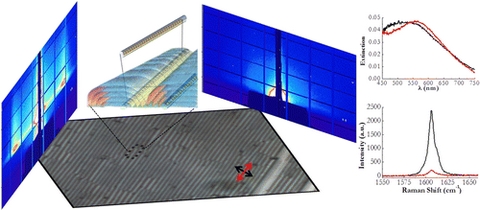 |
| We investigated composite films of gold nanoparticles (NPs)/liquid crystal (LC) defects as a model system to understand the key parameters, which allow for an accurate control of NP anisotropic self-assemblies using soft templates. We combined spectrophotometry, Raman spectroscopy, and grazing incidence small-angle X-ray scattering with calculations of dipole coupling models and soft sphere interactions. We demonstrate that dense arrays of elementary edge dislocations can strongly localize small NPs along the defect cores, resulting in formation of parallel chains of NPs. Furthermore, we show that within the dislocation cores the inter-NP distances can be tuned. This phenomenon appears to be driven by the competition between “soft (nano)sphere” attraction and LC-induced repulsion. We evidence two extreme regimes controlled by the solvent evaporation: (i) when the solvent evaporates abruptly, the spacing between neighboring NPs in the chains is dominated by van der Waals interactions between interdigitated capping ligands, leading to chains of close-packed NPs; (ii) when the solvent evaporates slowly, strong interdigitation between the is avoided, leading to a dominating LC-induced repulsion between NPs associated with the replacement of disordered cores by NPs. The templating of NPs by topological defects, beyond the technological inquiries, may enable creation, investigation, and manipulation of unique collective features for a wide range of nanomaterials. |

- «Lead-Free α-La2WO6 Ferroelectric Thin Films»
T. Carlier, M.-H. Chambrier, A. Ferri, S. Estradé, J.-F. Blach, G. Martín, B. Meziane, F. Peiró, P. Roussel, F. Ponchel, D. Rèmiens, A. Cornet, R. Desfeux
ACS Appl. Mater. Interfaces, 2015, 7 (44), pp 24409–24418 - doi: 10.1021/acsami.5b01776
IF = 7,145
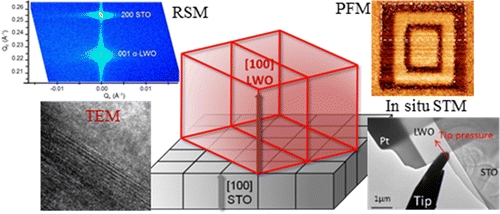 |
| (001)-Epitaxial La2WO6 (LWO) thin films are grown by pulsed laser deposition on (001)-oriented SrTiO3 (STO) substrates. The α-phase (high-temperature phase in bulk) is successfully stabilized with an orthorhombic structure (a = 16.585(1) Å, b = 5.717(2) Å, c = 8.865(5) Å). X-ray-diffraction pole-figure measurements suggest that crystallographic relationships between the film and substrate are [100]LWO ∥ [110]STO, [010]LWO ∥ [11̅0]STO and [001]LWO ∥ [001]STO. From optical properties, investigated by spectroscopic ellipsometry, we extract a refractive-index value around 2 (at 500 nm) along with the presence of two absorption bands situated, respectively at 3.07 and 6.32 eV. Ferroelectricity is evidenced as well on macroscale (standard polarization measurements) as on nanoscale, calling for experiments based on piezo-response force-microscopy, and confirmed with in situ scanning-and-tunneling measurements performed with a transmission electron microscope. This work highlights the ferroelectric behavior, at room temperature, in high-temperature LWO phase when stabilized in thin film and opens the way to new functional oxide thin films dedicated to advanced electronic devices. |

- «Bio-inspired Titanium Drug Eluting Platforms Based on Poly-β-cyclodextrin/chitosan Layer-by- Layer Self Assembly Targeting Infections»
A. Perez Anes, M. Gargouri , W. Laure , H. Van den Berghe , E. Courcot , J. Sobocinski , N. Tabary , F. Chai , J-F. Blach , A. Addad , P. Woisel , D. Douroumis , B. Martel , N. Blanchemain , and J. Lyskawa
ACS Appl. Mater. Interfaces, 2015, 7 (23), pp 12882–12893 - doi: 10.1021/acsami.5b02402
IF = 7,145
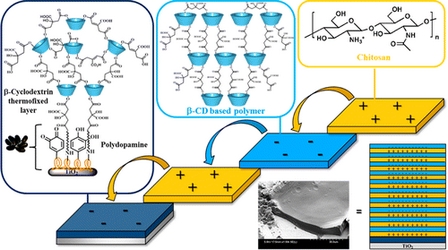 |
| In the field of implantable titanium-based biomaterials, infections and inflammations are the most common forms of postoperative complications. The controlled local delivery of therapeutics from implants through polyelectrolyte multilayers (PEMs) has recently emerged as a versatile technique that has shown great promise in the transformation of a classical medical implant into a drug delivery system. Herein, we report the design and the elaboration of new biodegradable multidrug-eluting titanium platforms based on a polyelectrolyte multilayer bioactive coating that target infections. These systems were built up in mild conditions according to the layer-by-layer (L-b-L) assembly and incorporate two biocompatible polysaccharides held together through electrostatic interactions. A synthetic, negatively charged β-cyclodextrin-based polymer (PCD), well-known for forming stable and reversible complexes with hydrophobic therapeutic agents, was exploited as a multidrug reservoir, and chitosan (CHT), a naturally occurring, positively charged polyelectrolyte, was used as a barrier for controlling the drug delivery rate. These polyelectrolyte multilayer films were strongly attached to the titanium surface through a bioinspired polydopamine (PDA) film acting as an adhesive first layer and promoting the robust anchorage of PEMs onto the biomaterials. Prior to the multilayer film deposition, the interactions between both oppositely charged polyelectrolytes, as well the multilayer growth, were monitored by employing surface plasmon resonance (SPR). Several PEMs integrating 5, 10, and 15 bilayers were engineered using the dip coating strategy, and the polyelectrolyte surface densities were estimated by colorimetric titrations and gravimetric analyses. The morphologies of these multilayer systems, as well as their naturally occurring degradation in a physiological medium, were investigated by scanning electron microscopy (SEM), and their thicknesses were measured by means of profilometry and ellipsometry studies. Finally, the ability of the coated titanium multilayer devices to act as a drug-eluting system and to treat infections was validated with gentamicin, a relevant water-soluble antibiotic commonly used in medicine due to its broad bactericidal spectrum. |

- «Biphasic palladium catalyzed hydroesterification reaction in a polyol phase: Selective synthesis of derived monoesters»
R. Pruvost, J. Boulanger, B. Léger, A. Ponchel, E. Monflier, M. Ibert, A. Mortreux, M. Sauthier
ChemSusChem, 8, 1989–2137 - doi: 10.1002/cssc.201403397
IF = 7,116
| |
| The palladium-catalyzed hydroesterification reaction was performed with polyols and olefins in a liquid/liquid biphasic system composed of unreacted polyol on the one hand and apolar reaction products/organic solvents on the other hand. The palladium-based catalyst was immobilized in the polyol phase thanks to the use of cationic triarylphosphines possessing pendent protonated amino groups in the acidic reaction medium or to the sulfonated phosphine TPPTS (trisodium triphenylphosphine-3,3′,3′′-trisulfonate). Owing to the insolubility of the products in the catalytic phase, this approach allowed the synthesis of monoesters of polyols with high selectivities as well as the easy separation of the catalyst through simple decantation. |

- «Supramolecular emulsifiers in biphasic catalysis: the substrate drives its own transformation»
T. Vanbésien, F. Hapiot, E. Monflier
ACS Catal. 2015, , 5, 4288-4292 - doi: 10.1021/acscatal.5b00861
IF = 9,307
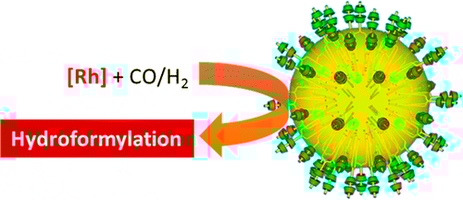 |
| Naturally occurring triglycerides have been hydroformylated through supramolecular means in the presence of cyclodextrins (CDs). During the course of the reaction, a transient supramolecular complex is formed between triglyceride alkyl chains and the appropriate CDs in a well-defined concentration range. The resulting CD/triglyceride supramolecular emulsifiers help convert the triglyceride C═C double bonds in biphasic conditions using a water-soluble organometallic catalyst. The catalytic system could be efficiently recycled. |

- «Catalytic decarbonylation of biosourced substrates»
J. Ternel, T. Lebarbé, E. Monflier, F. Hapiot
ChemSusChem 2015, 8, 1585-1592 - doi: 10.1002/cssc.201500214
IF = 7,116
| |
| Linear α-olefins (LAO) are one of the main targets in the field of surfactants, lubricants, and polymers. With the depletion of petroleum resources, the production of LAO from renewable feedstocks has gained increasing interest in recent years. In the present study, we demonstrated that Ir catalysts were suitable to decarbonylate a wide range of biosourced substrates under rather mild conditions (160 °C, 5 h reaction time) in the presence of potassium iodide and acetic anhydride. The resulting LAO were obtained with good conversion and selectivity provided that the purity of the substrate, the nature of the ligand, and the amounts of the additives were controlled accurately. The catalytic system could be recovered efficiently by using a Kugelrohr distillation apparatus and recycled. |

- «Ruthenium-containing β-cyclodextrin polymer globules for the catalytic hydrogenation of biomass-derived furanic compounds»
R. Herbois, S. Noël, B. Léger, S. Tilloy, S. Menuel, A. Addad, B. Martel, A. Ponchel, E. Monflier
Green Chem. 2015, 17, 2444 - 2454 - doi: 10.1039/C5GC00005J
IF = 8,506
 |
| Robust and highly efficient ruthenium nanoparticles confined within individual microenvironments formed by a three-dimensional β-cyclodextrin polymer were easily prepared for the hydrogenation of biomass-derived furan compounds in water. |

- «Thermoresponsive self-assembled cyclodextrin-end-decorated PNIPAM for aqueous catalysis»
J. Potier, S. Menuel, J. Lyskawa, D.Fournier, F. Stoffelbach, E. Monflier, P. Woisel, F. Hapiot
Chem. Commun., 2015, 51, 2328-2330 - doi: 10.1039/c4cc09052g
IF = 6,567
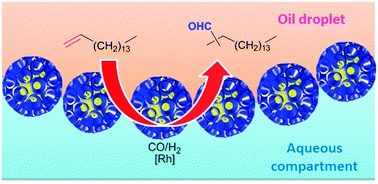 |
| The catalytic performance of thermoresponsive poly(N-isopropylacrylamide) (PNIPAM) functionalized at the terminal position with randomly methylated β-cyclodextrin was demonstrated by the aqueous Rh-catalysed hydroformylation of higher olefins. |

Faculté Jean Perrin - rue Jean Souvraz - SP 18 - 62307 Lens Cedex
tel : 03 21 79 17 05
fax : 03 21 79 17 55 |






